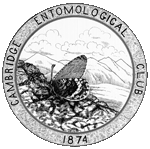
| January 2008: Psyche has a new publisher, Hindawi Publishing, and is accepting submissions |
Article beginning on page 162.
Psyche 3:162, 1880.
Full text (searchable PDF)
Durable link: http://psyche.entclub.org/3/3-162.html
The following unprocessed text is extracted from the PDF file, and is likely to be both incomplete and full of errors. Please consult the PDF file for the complete article.
162 PSYCHE.
PSYCHE.
CAMBRIDGE, MASS., JAN. 1881.
Communications, exckattg'es and editors' copies hodd be addressed to EDITORS OF PSYCHE, Cam bridge, Mass. Commztnications for pdZication in PSYCHE must be properly authenticated, and no anony- mous articles will be published.
Editors and contributors are only responsible for the statements made in their own comnwnications. Works on subjects not related to entomology will not be reviewed in PSYCHE.
For rates of subsrriftion and of advertising, see advertising columns.
PROCEEDINGS OF SOCIETIES.
12 Nov. 1880. - 71st meeting. The fol-
lowing persons were elected to membership : W : Barnes, of Decatur, 111. ; J : A. Ryder, of Philadelphia, Pa. ; S : Wendell Williston, of New Haven, Conn.; Miss Emily Adella
Smith, of Peoria, 111.; Gustav Thotnmen. of Lowell, Mass. . , . Dr. E :'L. Mark exhibited some drawings which he had made, illustra- tive of the external anatomy of the head and thorax of a larva allied to Lit?zocolleti.s, which he had found mining in the leaves of Accr. The special point of interest to which Dr. Mark called attention in connection with these drawings was the indication of the ex- istence of organs performing the function of prop-legs, on the back of the thoracic rings. Dr. Mark was not aware that such organs had been noticed in lepidopterous larvae.
He re-
ferred to the discovery of abdominal legs in the embryos of Hydrofkilus, Mantissa and Ca@odea, by different observers. . . . Notice was taken of the death of Jacob Boll, of Dal- las, Texas. . . .' Mr. W: Trelease said he had taken individuals of the genus Apafhus on flowers of Tigridia, engaged in supply- ing themselves with food. Mr. S: Henshaw said he also had taken a few of these bees on flowers. . . . Mr. Roland Hayward ex- hibited a specimen of Calosoma wilcoxii, taken at Nantucket, Mass. Mr. S: Henshaw said that he had recorded about half a
dozen captures of this species in eastern Massachusetts. . . . Mr. W : Barnes said he had captured several specimens of Anthocka~is oiymjia and of Terias nicz'pfe in Central Il- linois. This region is the meeting place of the southern and northern faunae. The limits of the faunae come within fifty kilometres of each other, and are not indicated by any geographical feature. Mr. Barnes said he had found Pafilio cresfhontes feeding on the hop tree (Ptelea trifoliata). . . . Mr. W : Trelease said he had found Harjalus caligi- nosus feeding on the ripening seeds of the rag-weed (Ambrosia artemisiaefolio). Mr. Roland Hayward said he had found H. $em- sylvanicus, H. conz$ay and H.faunns on the same plant. Mr. E: P. Austin said he had found several species of carabidae feeding on plants, some of them eating the leaves. . . . Mr. W : Trelease said that the young leaves of poplar trees (Pofulus) had nectar glands on ,
the petioles, to which he had found ants and parasitic hymenoptera attracted for the sake of feeding on the nectar. In a grove of
Japanese persimmon trees (Diosiiyros) in the grounds of the Department of Agriculture at Washington, the leaves had been distorted by a homopterous insect which produced honey- dew upon them, and he had seen numerous
honey-bees visiting these leaves to obtain the honey-dew. He had also seen humming bees (Bombus) feeding on carrion. He had found Vests maculata cutting holes 3 mm. in diam- eter in the flowers of Rites cynosiati; he had also found ants cutting holes in a similar manner in these flowers, and perforating the corolla of Salvia s'plendens near the mouth of the calyx. Prof. J : H : Comstock had found a fungus (" Sco~ius sfongiosus ") growing on the honey-dew produced by woolly plant-lice [Briosoma?]. Fungus had also been found
on the honey-dew produced by coccidae on the orange tree (Citrus).
================================================================================
Volume 3 table of contents